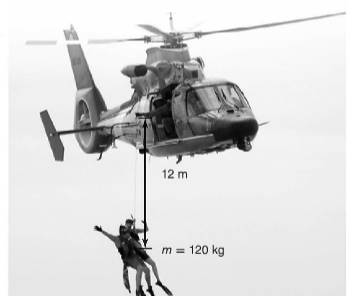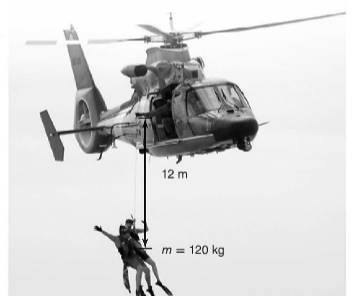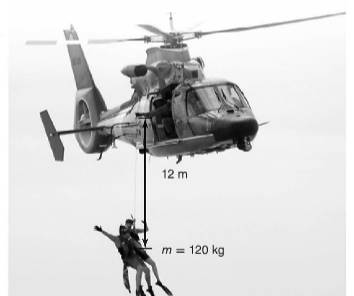
Concept explainers
(a)
Maximum mass that a winch can lift.
(a)
Answer to Problem 51A
Maximum mass a winch can lift is 204.08 kg.
Explanation of Solution
Given:
The given figure is shown below.

Formula used:
According to Newton’s 2nd law, force is given by the formula,
Where,
m is mass of the body
a is acceleration of body
Calculation:
Maximum mass that can be lifted by winch is,
(b)
The rescue’s and victim’s acceleration.
To draw: A free body diagram of the people being lifted.
(b)
Answer to Problem 51A
The acceleration of victim is 9.8 m/s2 and acceleration of rescue is 0.2 m/s2.
A free body diagram of the people being lifted is shown in Figure 1.
Explanation of Solution
Given:
The given figure is shown below.

Calculation:
From part (a), the maximum mass is
Winch force is acting in the upward direction that is along positive y -direction
Mass of victims = 120 kg
Force exerted by the victim is,
The direction of force in the downward direction that is along negative y -direction.
Total force exerted on victim is,
(Considering force along positive y -direction is positive and along negative y -direction is negative)
Positive sign of the force signifies that the resultant force in the direction of positive y- direction.
Acceleration of rescuer is
The free-body diagram is shown below.

Figure 2
(c)
Time taken to pull the people up to the helicopter.
(c)
Answer to Problem 51A
Time taken to pull the people up to the helicopter is 10.95 sec.
Explanation of Solution
Given:
The given figure is shown below.

Initially victims are stationary
Distance between rescue and victim is 12 m.
Rescue’s acceleration is,
Formula used:
The equation of motion is,
Calculation:
Substituting the values in above equation.
Chapter 4 Solutions
Glencoe Physics: Principles and Problems, Student Edition
Additional Science Textbook Solutions
College Physics
University Physics Volume 1
College Physics (10th Edition)
Physics for Scientists and Engineers: A Strategic Approach, Vol. 1 (Chs 1-21) (4th Edition)
University Physics Volume 2
Sears And Zemansky's University Physics With Modern Physics
 College PhysicsPhysicsISBN:9781305952300Author:Raymond A. Serway, Chris VuillePublisher:Cengage Learning
College PhysicsPhysicsISBN:9781305952300Author:Raymond A. Serway, Chris VuillePublisher:Cengage Learning University Physics (14th Edition)PhysicsISBN:9780133969290Author:Hugh D. Young, Roger A. FreedmanPublisher:PEARSON
University Physics (14th Edition)PhysicsISBN:9780133969290Author:Hugh D. Young, Roger A. FreedmanPublisher:PEARSON Introduction To Quantum MechanicsPhysicsISBN:9781107189638Author:Griffiths, David J., Schroeter, Darrell F.Publisher:Cambridge University Press
Introduction To Quantum MechanicsPhysicsISBN:9781107189638Author:Griffiths, David J., Schroeter, Darrell F.Publisher:Cambridge University Press Physics for Scientists and EngineersPhysicsISBN:9781337553278Author:Raymond A. Serway, John W. JewettPublisher:Cengage Learning
Physics for Scientists and EngineersPhysicsISBN:9781337553278Author:Raymond A. Serway, John W. JewettPublisher:Cengage Learning Lecture- Tutorials for Introductory AstronomyPhysicsISBN:9780321820464Author:Edward E. Prather, Tim P. Slater, Jeff P. Adams, Gina BrissendenPublisher:Addison-Wesley
Lecture- Tutorials for Introductory AstronomyPhysicsISBN:9780321820464Author:Edward E. Prather, Tim P. Slater, Jeff P. Adams, Gina BrissendenPublisher:Addison-Wesley College Physics: A Strategic Approach (4th Editio...PhysicsISBN:9780134609034Author:Randall D. Knight (Professor Emeritus), Brian Jones, Stuart FieldPublisher:PEARSON
College Physics: A Strategic Approach (4th Editio...PhysicsISBN:9780134609034Author:Randall D. Knight (Professor Emeritus), Brian Jones, Stuart FieldPublisher:PEARSON





